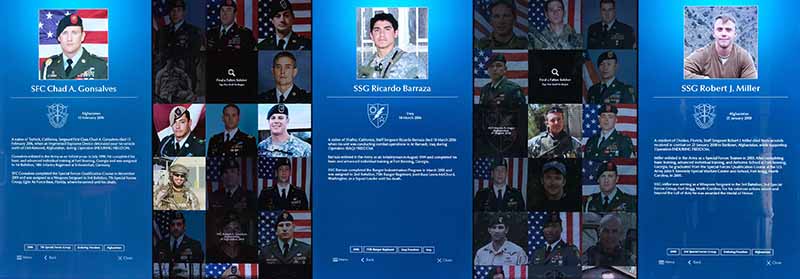RELATED
DOWNLOAD
Following the devastating terrorist attacks of 11 September 2001, the nation turned to the U.S. Army Special Operations Command (USASOC) as its premier experts in irregular and unconventional warfare, to spearhead what came to be known as the Global War on Terrorism (GWOT). The overarching mission, in the words of President George W. Bush, was to “bring our enemies to justice or justice to our enemies.” From October 2001 forward, Army Special Operations Forces (ARSOF) have been continuously engaged in that fight. Perhaps no single formation has sacrificed more during the twenty-one years since 9/11. This essay reflects on that sacrifice and how we remember it.
Army Special Operations lost its first soldier of this new era when Major Wallace C. Hogan, a Special Forces (SF) officer, was killed when Al Qaeda hijackers crashed American Airlines Flight 77 into the Pentagon on 9/11. On 26 August 2021, 7,290 days later, Staff Sergeant (SSG) Ryan C. Knauss, a Psychological Operations (PSYOP) soldier, was mortally wounded in a suicide bombing at Hamid Karzai International Airport in Kabul, Afghanistan. The intervening 7,289 days of continuous warfare claimed 375 additional ARSOF soldiers. Collectively, they are the Fallen.
Just inside the main entrance to the USASOC Headquarters (Major General Robert A. McClure Building) on Fort Bragg, North Carolina, stands a forty-one-foot-tall digital memorial wall, dedicated to the memory of the ARSOF Fallen of the post-9/11 era. It represents the covenant between USASOC and its fallen soldiers that they will not be forgotten and signifies the enduring promise USASOC makes to its Gold Star families.

The 377 Fallen currently engraved on this wall range in age from 18 to 58 years old. They hailed from forty-seven different U.S. states, the District of Columbia, Puerto Rico, and nine foreign countries. Forty-four native Californians made the ultimate sacrifice, as did thirty Texans, seventeen Pennsylvanians, sixteen Ohioans, and fourteen Washingtonians.

Five of the Fallen were female, three from Civil Affairs and two belonging to Cultural Support Teams, a GWOT-era innovation. Two of the Fallen, SSG Robert J. Miller of 3rd Special Forces Group (SFG) and Sergeant First Class Christopher A. Celiz of the 75th Ranger Regiment, were posthumously awarded the Medal of Honor.
All seven Special Forces Groups (SFGs) are represented on the wall – 200 soldiers in all – with 3rd SFG (58) and 7th SFG (51) accounting for over half this number. Seventy Fallen were assigned or attached to the 75th Ranger Regiment, 36 to the 160th Special Operations Aviation Regiment, 33 to Civil Affairs, 15 to PSYOP, 22 to other Special Operations Task Forces or units, and one to the Headquarters, Department of the Army.
Of the twelve countries where ARSOF soldiers fell, Afghanistan was by far the deadliest, accounting for 247 (67%) of the total number. Fighting in Iraq was also brutal, costing ARSOF 98 soldiers. Twelve fell in the Philippines, five in Pakistan, four in Niger, three in Jordan, two each in Syria and Mali, and one each in Somalia, Yemen, Kuwait, and the United States.
Of the 377 Fallen, 271 were lost between 2001 and 2010. The deadliest year for ARSOF was 2005, which claimed forty-three soldiers. The two years that followed cost ARSOF 35 and 36 lives, respectively. During this period, deadly insurgencies raged in both Iraq and Afghanistan.

2001, MAJ Hogan bio

2008, SSG Miller bio

2018, SFC Celiz bio

2021, SSG Knauss bio
On average, ARSOF lost one of its number every nineteen days. However, some days were costlier than others. On two occasions, 22 February 2002 and 25 June 2005, ARSOF lost eight soldiers in one day. Both involved helicopter crashes, one in the Philippines and one in Afghanistan. Two other days, 18 February 2007 and 26 October 2009, cost ARSOF seven soldiers. But each of the 273 days on which ARSOF lost one or more of its members made a lasting impact on the fallen soldiers’ families, friends, and comrades.
It is for this reason that the digital memorial wall cannot be reduced to numbers. It is first and foremost about people. Its most striking characteristic is 377 faces of the Fallen, each accompanied by a brief biography. These faces greet all who enter and leave the MG McClure Building. They are the constant reminder of the price of freedom, and of USASOC’s enduring promise to its Fallen, and to their families. They recall the words of the Canadian soldier-poet, John McCrae from 1915:
We are the Dead. Short days ago
We lived, felt dawn, saw sunset glow,
Loved and were loved, and now we lie,
In Flanders fields.
As part of the USASOC History Office, I have the privilege of briefing the digital memorial wall to distinguished visitors, to onboarding USASOC personnel, and, most importantly, to Gold Star families. Each time I do, I am reminded of Abraham Lincoln’s closing remarks at Gettysburg, Pennsylvania, in November 1863:
The world will little note, nor long remember what we say here, but it can never forget what they did here. It is for us the living, rather, to be dedicated here to the unfinished work which they who fought here have thus far so nobly advanced. It is rather for us to be here dedicated to the great task remaining before us — that from these honored dead we take increased devotion to that cause for which they gave the last full measure of devotion.
The History Office encourages everyone who works at, or is able to visit, USASOC Headquarters to spend some time interacting with this memorial for yourself. For those unable to do so, you can access each Fallen soldier’s photo and biography on the USASOC History website. Additional information about USASOC’s memorialization efforts is available at Headquarters, USASOC: Honoring ARSOF History, Legacy, and Sacrifice.
Never forget.
